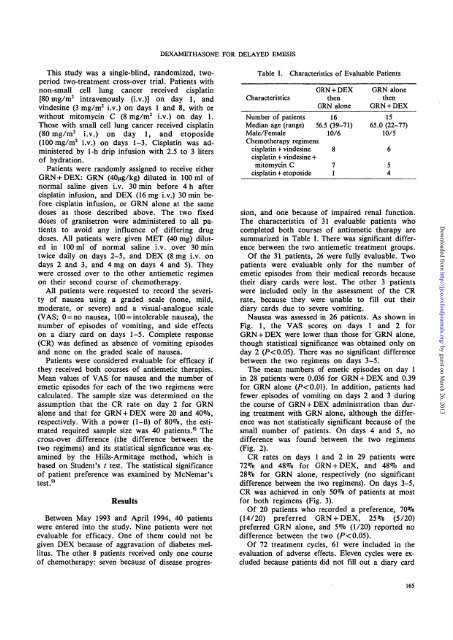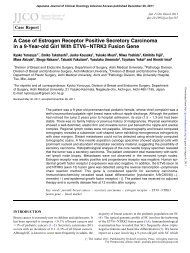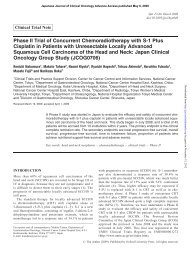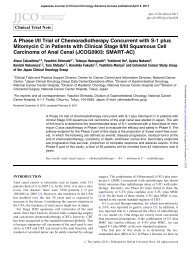A Randomized Cross-over Trial of Granisetron and Dexamethasone ...
A Randomized Cross-over Trial of Granisetron and Dexamethasone ...
A Randomized Cross-over Trial of Granisetron and Dexamethasone ...
You also want an ePaper? Increase the reach of your titles
YUMPU automatically turns print PDFs into web optimized ePapers that Google loves.
This study was a single-blind, r<strong>and</strong>omized, twoperiod<br />
two-treatment cross-<strong>over</strong> trial. Patients with<br />
non-small cell lung cancer received cisplatin<br />
[80 mg/m 2 intravenously (i.v.)] on day 1, <strong>and</strong><br />
vindesine (3 mg/m 2 i.v.) on days 1 <strong>and</strong> 8, with or<br />
without mitomycin C (8 mg/m 2 i.v.) on day 1.<br />
Those with small cell lung cancer received cisplatin<br />
(80 mg/m 2 i.v.) on day 1, <strong>and</strong> etoposide<br />
(100 mg/m 2 i.v.) on days 1-3. Cisplatin was administered<br />
by 1-h drip infusion with 2.5 to 3 liters<br />
<strong>of</strong> hydration.<br />
Patients were r<strong>and</strong>omly assigned to receive either<br />
GRN + DEX: GRN (40/tg/kg) diluted in 100 ml <strong>of</strong><br />
normal saline given i.v. 30 min before 4 h after<br />
cisplatin infusion, <strong>and</strong> DEX (16 mg i.v.) 30 min before<br />
cisplatin infusion, or GRN alone at the same<br />
doses as those described above. The two fixed<br />
doses <strong>of</strong> granisetron were administered to all patients<br />
to avoid any influence <strong>of</strong> differing drug<br />
doses. All patients were given MET (40 mg) diluted<br />
in 100 ml <strong>of</strong> normal saline i.v. <strong>over</strong> 30 min<br />
twice daily on days 2-5, <strong>and</strong> DEX (8 mg i.v. on<br />
days 2 <strong>and</strong> 3, <strong>and</strong> 4 mg on days 4 <strong>and</strong> 5). They<br />
were crossed <strong>over</strong> to the other antiemetic regimen<br />
on their second course <strong>of</strong> chemotherapy.<br />
All patients were requested to record the severity<br />
<strong>of</strong> nausea using a graded scale (none, mild,<br />
moderate, or severe) <strong>and</strong> a visual-analogue scale<br />
(VAS; 0 = no nausea, 100 = intolerable nausea), the<br />
number <strong>of</strong> episodes <strong>of</strong> vomiting, <strong>and</strong> side effects<br />
on a diary card on days 1-5. Complete response<br />
(CR) was defined as absence <strong>of</strong> vomiting episodes<br />
<strong>and</strong> none on the graded scale <strong>of</strong> nausea.<br />
Patients were considered evaluable for efficacy if<br />
they received both courses <strong>of</strong> antiemetic therapies.<br />
Mean values <strong>of</strong> VAS for nausea <strong>and</strong> the number <strong>of</strong><br />
emetic episodes for each <strong>of</strong> the two regimens were<br />
calculated. The sample size was determined on the<br />
assumption that the CR rate on day 2 for GRN<br />
alone <strong>and</strong> that for GRN + DEX were 20 <strong>and</strong> 40%,<br />
respectively. With a power (1-6) <strong>of</strong> 80%, the estimated<br />
required sample size was 40 patients. 8 ' The<br />
cross-<strong>over</strong> difference (the difference between the<br />
two regimens) <strong>and</strong> its statistical signficance was examined<br />
by the Hills-Armitage method, which is<br />
based on Student's t test. The statistical significance<br />
<strong>of</strong> patient preference was examined by McNemar's<br />
test. 9 '<br />
Results<br />
Between May 1993 <strong>and</strong> April 1994, 40 patients<br />
were entered into the study. Nine patients were not<br />
evaluable for efficacy. One <strong>of</strong> them could not be<br />
given DEX because <strong>of</strong> aggravation <strong>of</strong> diabetes mellitus.<br />
The other 8 patients received only one course<br />
<strong>of</strong> chemotherapy: seven because <strong>of</strong> disease progres-<br />
DEXAMETHASONE FOR DELAYED EMESIS<br />
Table I. Characteristics <strong>of</strong> Evaluable Patients<br />
Characteristics<br />
GRN + DEX<br />
then<br />
GRN alone<br />
Number <strong>of</strong> patients 16<br />
Median age (range) 56.5 (39-71)<br />
Male/Female<br />
10/6<br />
Chemotherapy regimens<br />
cisplatin + vindesine<br />
cisplatin + vindesine +<br />
8<br />
mitomycin C<br />
7<br />
cisplatin + etoposide 1<br />
GRN alone<br />
then<br />
GRN + DEX<br />
15<br />
65.0 (22-77)<br />
10/5<br />
sion, <strong>and</strong> one because <strong>of</strong> impaired renal function.<br />
The characteristics <strong>of</strong> 31 evaluable patients who<br />
completed both courses <strong>of</strong> antiemetic therapy are<br />
summarized in Table I. There was significant difference<br />
between the two antiemetic treatment groups.<br />
Of the 31 patients, 26 were fully evaluable. Two<br />
patients were evaluable only for the number <strong>of</strong><br />
emetic episodes from their medical records because<br />
their diary cards were lost. The other 3 patients<br />
were included only in the assessment <strong>of</strong> the CR<br />
rate, because they were unable to fill out their<br />
diary cards due to severe vomiting.<br />
Nausea was assessed in 26 patients. As shown in<br />
Fig. 1, the VAS scores on days 1 <strong>and</strong> 2 for<br />
GRN + DEX were lower than those for "GRN alone,<br />
though statistical significance was obtained only on<br />
day 2 (P







